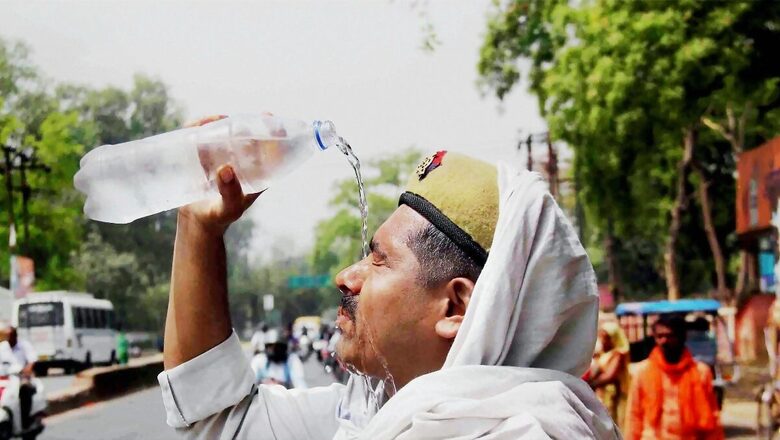
views
“It’s scorching hot today!” For many of us, this exclamation expresses our annoyance at the occasional inconveniences of the year’s hottest months. The blistering heatwaves across the country, especially in northern India, persist as the maximum temperature soared to 49 degrees Celsius in Rajasthan, the highest of this season, which caused a couple of people to die due to suspected heat-related ailments.
Punjab, Haryana, Uttar Pradesh, and Madhya Pradesh are also reeling from heatwaves. Conditions are expected to worsen as the India Meteorological Department (IMD) predicts temperatures in northwest India may reach nearly 50 degrees Celsius over the next few days, posing a threat to the millions of workers engaged in farming, construction, and industrial operations, signifying distress. For many economies, this poses a significant threat to productivity. Therefore, there is an urgent need for a climate-responsive action plan.
Effect on workforce and economy
The World Bank’s report unequivocally states that climate change is causing steadily rising temperatures in India, leading to more extreme heat each year. By 2030, over 160-200 million people across the country could be exposed to lethal heatwaves annually. Additionally, around 34 million people in India are projected to face job losses due to heat stress-related declines in productivity.
The impacts of rising average temperatures are being felt differently across various occupations and employment sectors. Jobs involving high levels of physical exertion or prolonged outdoor work are particularly affected by increasing heat levels. Specifically, agricultural and construction work, as well as work in steel plants and brick clans, are expected to be the worst affected.
According to a study by the International Labour Organisation (ILO), in 1995, the working hours lost in India due to heat stress were 5.87 per cent in agriculture and construction, 2.95 per cent in industry, and 0.63 per cent in services. These numbers are anticipated to increase to 9.04 per cent in agriculture and construction, 5.29 per cent in industry, and 1.48 per cent in services by 2030.
Heat stress is increasingly becoming an obstacle to economic activity. It reduces the ability of businesses to operate during the hottest hours, and temperature rises are expected to further diminish labour productivity, potentially rendering some agricultural areas unproductive and displacing a large number of farm workers. The global economic losses due to heat stress at work were estimated at $280 billion in 1995, and this figure is projected to increase to $2,400 billion in 2030.
Currently, the annual food loss due to heat during transportation is close to $13 billion. By 2037, the demand for cooling is likely to be eight times more than current levels. This means there will be a demand for a new air conditioner every 15 seconds, leading to an expected rise of 435 per cent in annual greenhouse gas emissions over the next two decades. Recognising this challenge, India must deploy new strategic sustainable solutions to help people adapt to rising temperatures.
Scope of sustainable solutions
The World Bank study ‘Climate Investment Opportunities in India’s Cooling Sector’, clearly indicates that utilising alternative and innovative energy-efficient technologies is the key to combating the heatwave crisis. This approach has the potential to open an investment opportunity of $1.6 trillion by 2040, significantly reduce greenhouse gas emissions, and create nearly 3.7 million jobs.
The study strongly suggests that a more energy-efficient pathway could lead to a substantial reduction in expected CO2 levels over the next two decades. India’s cooling strategy can save lives and livelihoods, reduce carbon emissions, and position India as a global hub for green cooling manufacturing. The report proposes a sustainable roadmap for cooling that could effectively reduce 300 million tonnes of carbon dioxide annually by 2040.
In 2019, the India Cooling Action Plan (ICAP) was launched to implement decisive and sustainable cooling measures across various sectors. These measures include indoor cooling in buildings, cold chain solar refrigeration in the agriculture and pharmaceutical sectors, and air-conditioning in passenger transport. The plan aims to reduce the demand for electricity-driven cooling by up to 25 per cent by 2037-38, potentially creating two million jobs for trained technicians and reducing the demand for refrigerants by around 31 per cent over the next two decades.
Adopting climate-responsive cooling techniques
It is imperative to adopt climate-responsive cooling techniques as the standard in both private and government-funded constructions to ensure that those at the bottom of the economic ladder are not disproportionately affected by rising temperatures. The report strongly advocates for the widespread adoption of such changes in India’s affordable housing program, which could benefit over 11 million urban homes and over 29 million rural houses that the government aims to construct.
Public-private investment in district-level cooling technologies is crucial. These cutting-edge technologies produce chilled water at a central plant, distributing it to multiple buildings via underground insulated pipes. This system drastically reduces cooling costs for individual buildings, slashing electricity bills by 20-30 per cent compared to even the most efficient conventional solutions. The Punjab Energy Development Agency (PEDA) office in Chandigarh stands as a prime example of a climate-responsive building, providing efficient cooling in summer and warmth in winter. Such models can be widely replicated in future green building construction.
To combat rising food and pharmaceutical wastage during transportation due to higher temperatures, the World Bank report unequivocally recommends addressing gaps in cold chain distribution networks. Investing in pre-cooling and refrigerated transport can substantially decrease food loss by about 76 per cent and reduce carbon emissions by 16 per cent.
India is resolute in its aim to phase out the production and use of ozone-depleting hydrochlorofluorocarbons, used as coolants in air conditioners and refrigerators. The report emphasises the urgency of improving servicing, maintenance, and disposal of equipment that uses hydrochlorofluorocarbons, alongside a swift shift to alternative options with a lower global warming footprint.
The way forward
It is crucial to comprehend the implications of climate change for the workplace, particularly for those most affected and vulnerable. The World Bank report also staunchly advocates for accelerating the structural transformation of rural economies by promoting the development of responsible and sustainable, or “green,” businesses. This will reduce the exposure of agricultural workers to high temperatures and minimise physical exertion in such conditions.
Other imperative policy measures include skills development, fostering an enabling environment for sustainable enterprises, and substantial public investment in infrastructure to address the climate crisis.
The Author is Vice-Chairman of Sonalika ITL Group, Vice-Chairman (Cabinet minister rank) of the Punjab Economic Policy and Planning Board, Chairman of ASSOCHAM Northern Region Development Council and President of Tractor and Mechanization Association (TMA). Views expressed in the above piece are personal and solely that of the author. They do not necessarily reflect News18’s views.















Comments
0 comment